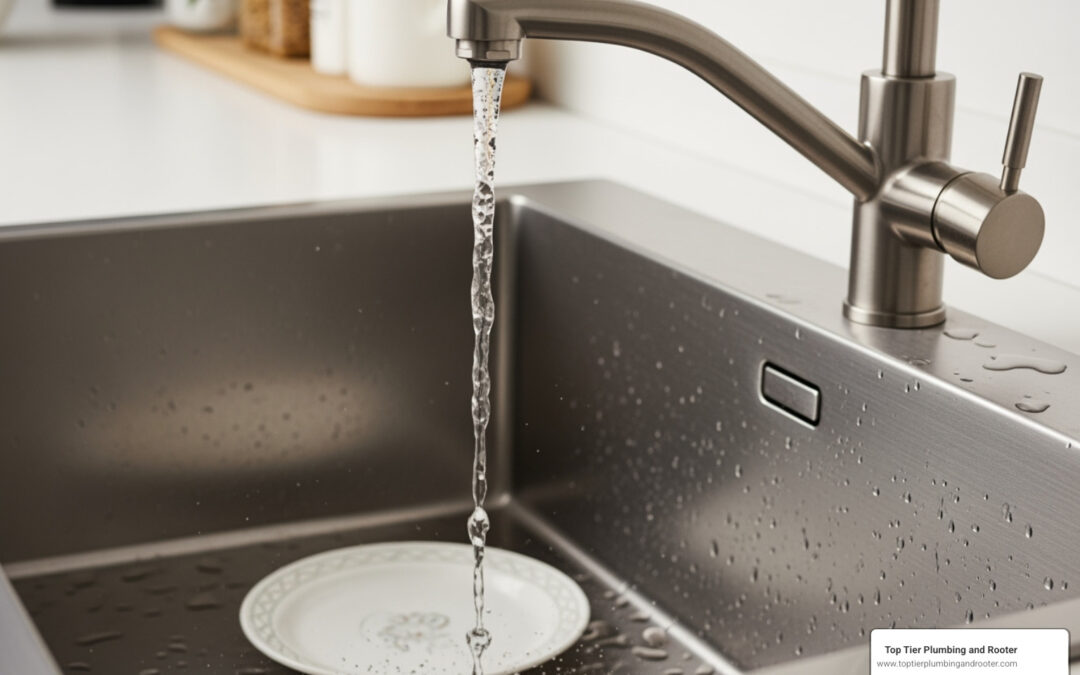Why Your Sink’s Water Pressure Matters
Low water pressure sink issues are one of the most frustrating plumbing problems homeowners face. Whether you’re trying to wash dishes or fill a pot for dinner, a weak trickle from your faucet turns simple tasks into lengthy ordeals.
Quick Solutions for Low Water Pressure in Your Sink:
- Check the aerator – Unscrew and clean the small screen at the faucet tip
- Inspect shutoff valves – Ensure hot and cold valves under sink are fully open
- Test other faucets – Determine if it’s a single sink or whole-house problem
- Look for leaks – Check under sink for puddles or moisture
- Clean the faucet cartridge – Remove buildup inside the faucet mechanism
The good news? Most sink water pressure problems have simple fixes you can tackle yourself. Clogged aerators cause about 80% of single-faucet pressure issues, and cleaning one takes just minutes with household vinegar.
However, if multiple faucets have low pressure, or you spot signs of leaks, the problem may run deeper into your home’s plumbing system. Corroded pipes, municipal supply issues, or water heater problems require different approaches.
In Riverside and San Bernardino counties, hard water makes aerator clogs especially common. The mineral buildup from our local water supply can turn a perfectly good faucet into a frustrating dribble in just months.
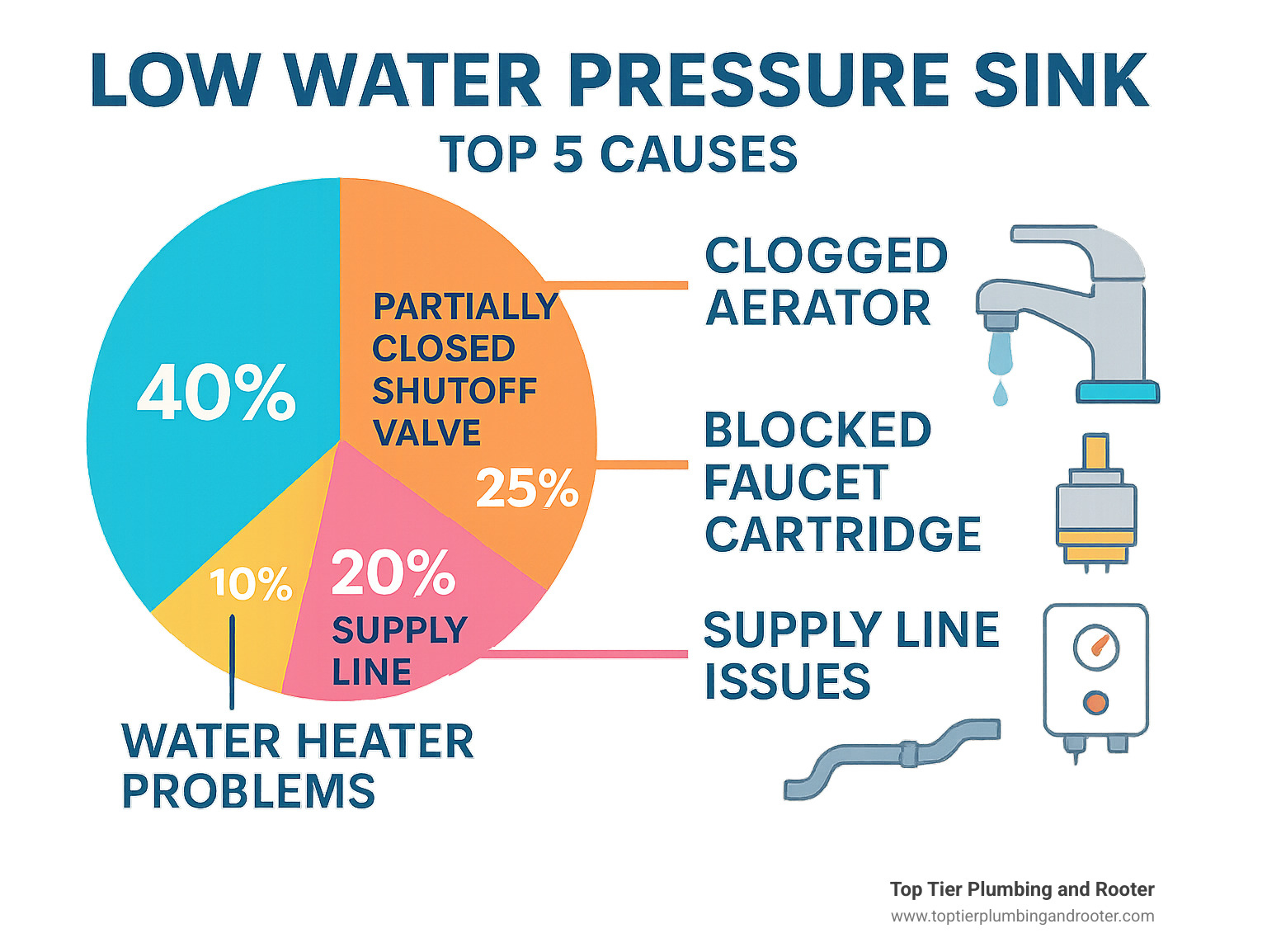
First Steps: Diagnosing the Source of the Problem
When your low water pressure sink starts acting up, don’t panic – but don’t ignore it either. The key to fixing any plumbing problem is figuring out exactly what you’re dealing with. Think of yourself as a detective gathering clues, because the symptoms you find will point you straight to the solution.
The most important question to answer first: Is this just your kitchen sink being difficult, or is your whole house staging a water pressure revolt? This single piece of information will save you hours of troubleshooting in the wrong direction.
How to Diagnose a Low Water Pressure Sink
Start your investigation by taking a quick tour of your home’s faucets. Turn on your bathroom sink – does it have the same weak flow? Head to the shower and see if it’s producing more of a gentle mist than a proper spray. Don’t forget about any utility sinks or laundry room faucets you might have.
If every faucet in your house is barely producing a trickle, you’re dealing with a whole-house problem. This could mean issues with your main water supply line, a faulty pressure regulator, or even problems with your municipal water supply. Time to ask your neighbors if they’re experiencing the same frustration – if they are, your local water utility company needs to hear about it.
But if it’s just your kitchen sink throwing a tantrum while everything else works fine, you can breathe a little easier. The problem is localized, which usually means simpler fixes like a clogged aerator or issues with that specific faucet’s components.
Here’s where things get interesting: test your hot and cold water separately at the problem sink. Turn on just the hot water handle, then just the cold. If only your hot water is weak, you’ve just narrowed down the culprit to your hot water line or water heater. If both are equally pathetic, the issue is likely with the faucet itself, its aerator, or the supply lines feeding that particular sink.
Don’t overlook your outdoor spigots during this detective work. If your garden hose connection has great pressure while your kitchen sink doesn’t, it confirms the problem is somewhere between your main line and that specific faucet.
Water heater issues deserve special attention here. If you’re only having hot water pressure problems, your water heater might be dealing with sediment buildup or other internal issues that we’ll explore later in this guide.
Understanding how water pressure regulation works in your home can really help with this diagnostic process. Your home’s pressure regulator – usually located where your main water line enters the house – keeps everything flowing consistently. For a deeper dive into this important component, check out our guide on The Importance of Water Pressure Regulation in Your Home.
The good news? Most low water pressure sink problems have straightforward solutions once you know what you’re dealing with. Take your time with this diagnostic phase – those few extra minutes of testing will pay off big time when you start the actual repairs.
Step-by-Step Guide to Fixing a Low Water Pressure Sink
Now that you’ve figured out whether your low water pressure sink is a solo act or part of a whole-house drama, it’s time to get your hands dirty with some fixes. The good news? Most of these problems are surprisingly simple to solve, and you probably already have everything you need in your kitchen drawer.
Before we dive in, grab these basic tools: a pair of pliers (wrap them in a cloth to protect your faucet’s finish), an old toothbrush, and some white vinegar. That’s it – no fancy equipment required!
The #1 Culprit: A Clogged Faucet Aerator
Let’s start with the most likely suspect: your faucet aerator. This little mesh screen at the tip of your spout is like a tiny traffic director, breaking up the water flow and mixing in air to give you that smooth, splash-free stream. But here’s the thing – it’s also a magnet for trouble.
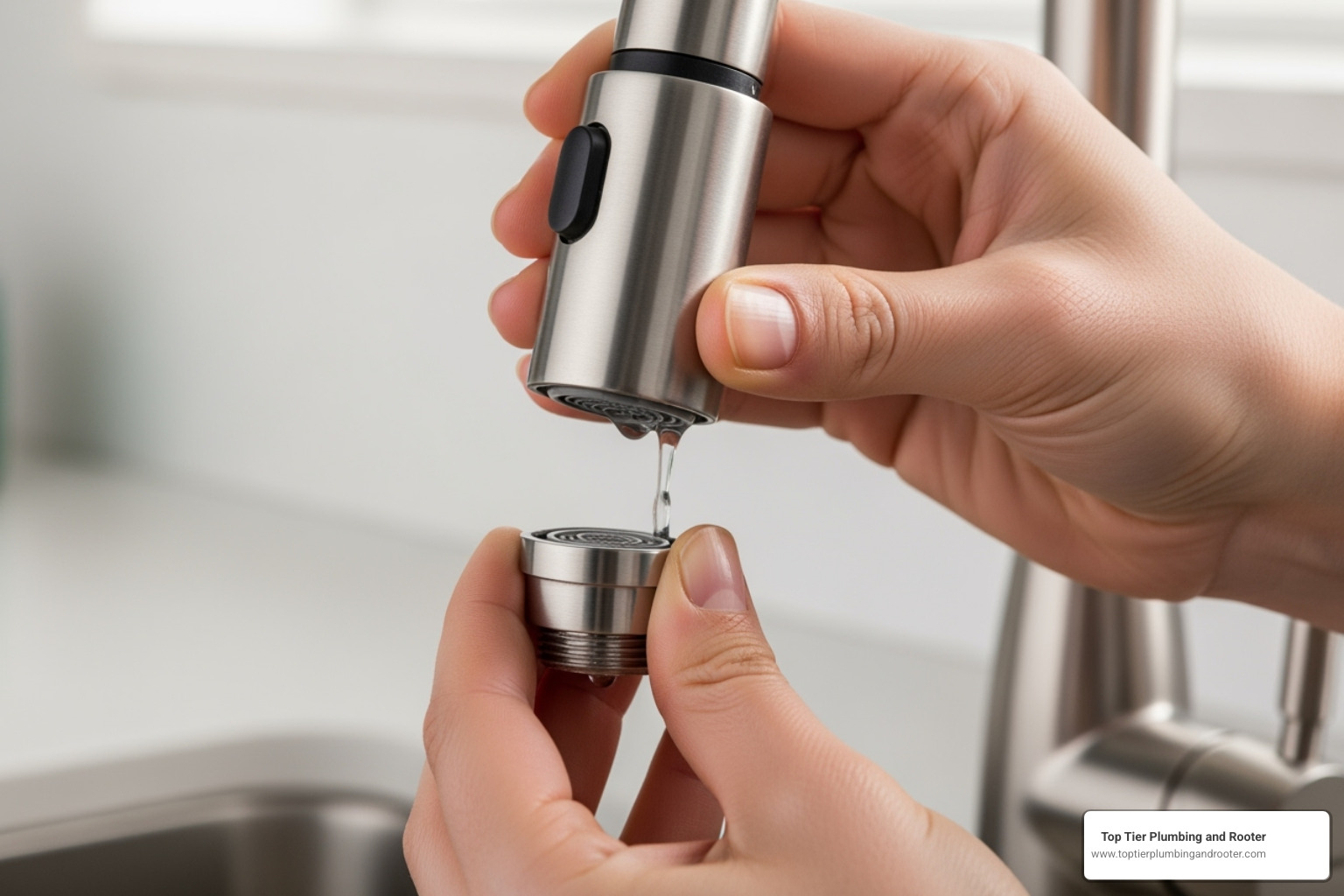
Over time, mineral deposits from hard water, sediment, and debris love to party in that mesh screen. In Riverside and San Bernardino counties, our hard water makes this problem especially common. What starts as a perfectly good faucet can turn into a frustrating trickle in just a few months.
The fix is refreshingly simple. Unscrew the aerator by turning it counter-clockwise – most come off by hand, but if it’s stubborn, use your cloth-wrapped pliers. Once you’ve got it off, take apart the little pieces inside. You’ll usually find a washer, a metal or plastic insert, and that all-important mesh screen.
Here’s where the magic happens: soak everything in white vinegar. A few hours will do for light buildup, but if your aerator looks like it’s been through a mineral storm, let it sit overnight. Vinegar is like kryptonite to calcium and lime deposits.
After the vinegar bath, give everything a good scrub with that old toothbrush. You’ll be amazed at what comes off! Rinse thoroughly, put the pieces back together (remember the order you took them apart), and screw the aerator back on. Turn on your faucet and prepare to be impressed – this simple fix solves about 80% of single-faucet pressure problems.
Checking the Shutoff Valves
If your aerator was squeaky clean or the cleaning didn’t solve your low water pressure sink woes, let’s check those shutoff valves hiding under your sink. Every sink has two of these little valve warriors – one for hot water, one for cold – and they’re often called “angle stops.”
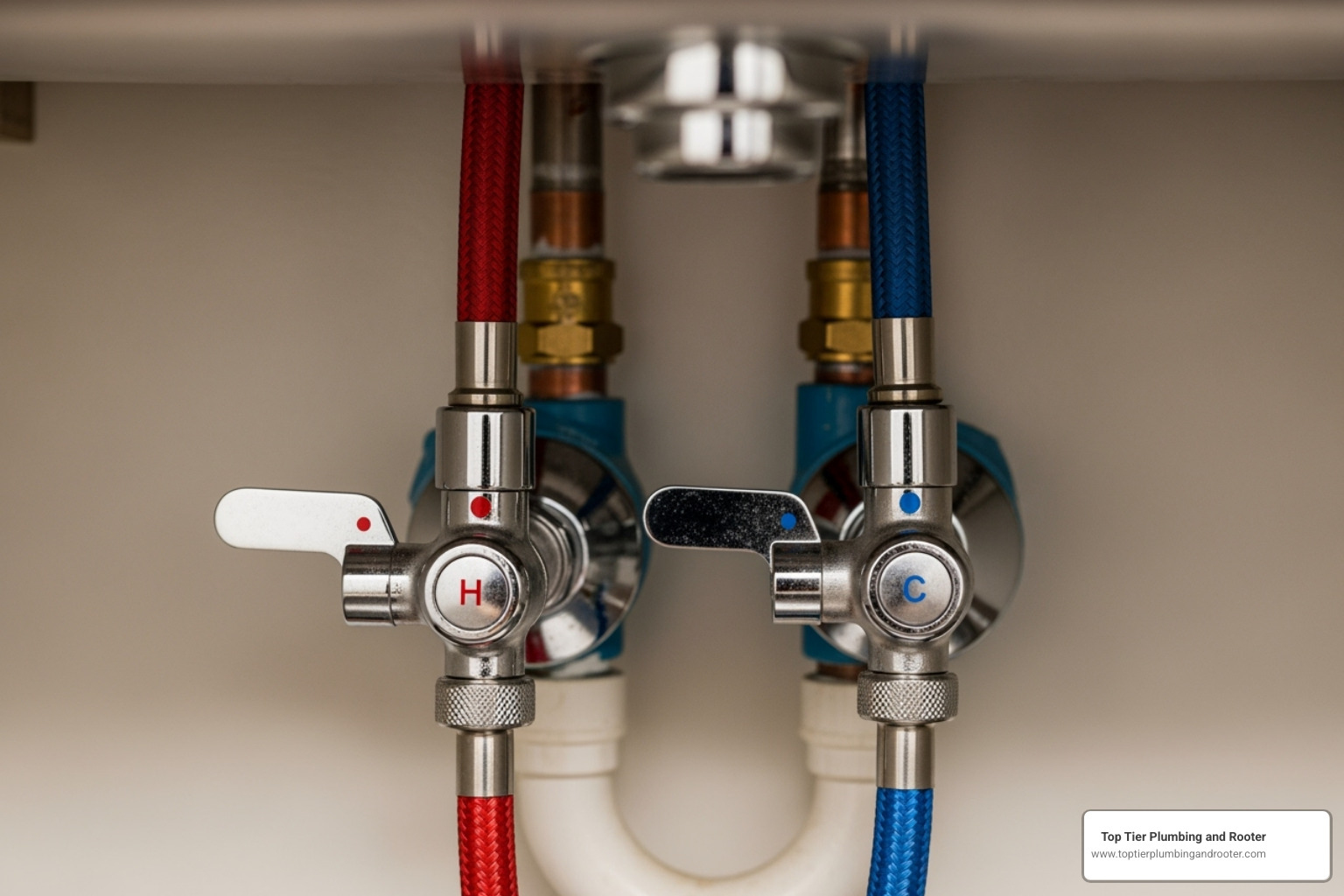
These valves can be sneaky troublemakers. Sometimes they get partially closed by accident – maybe someone was storing cleaning supplies under the sink and bumped one. Other times, they just get cranky with age and don’t open all the way, even when they look like they should.
Grab a flashlight and crawl under your sink for a quick investigation. Turn both valve handles counter-clockwise as far as they’ll go. This ensures they’re in the fully open position for maximum water flow. If they were already open, give them a gentle wiggle to make sure they’re not stuck internally.
While you’re down there playing plumber detective, take a look at those flexible supply lines running from the valves to your faucet. These can get kinked if items stored under the sink shift around, and a kinked line chokes off water flow just like stepping on a garden hose. Straighten out any bends you find.
This simple check often works like magic. We’ve seen plenty of homeowners scratch their heads over mysterious pressure problems, only to find that a family member accidentally nudged a valve while reaching for the dish soap.
Advanced Fixes for a Low Water Pressure Sink
Still dealing with that stubborn low water pressure sink? Time to go deeper into your faucet’s inner workings. The next suspect is your faucet cartridge – a small cylindrical component that lives inside your faucet and controls water flow and temperature.
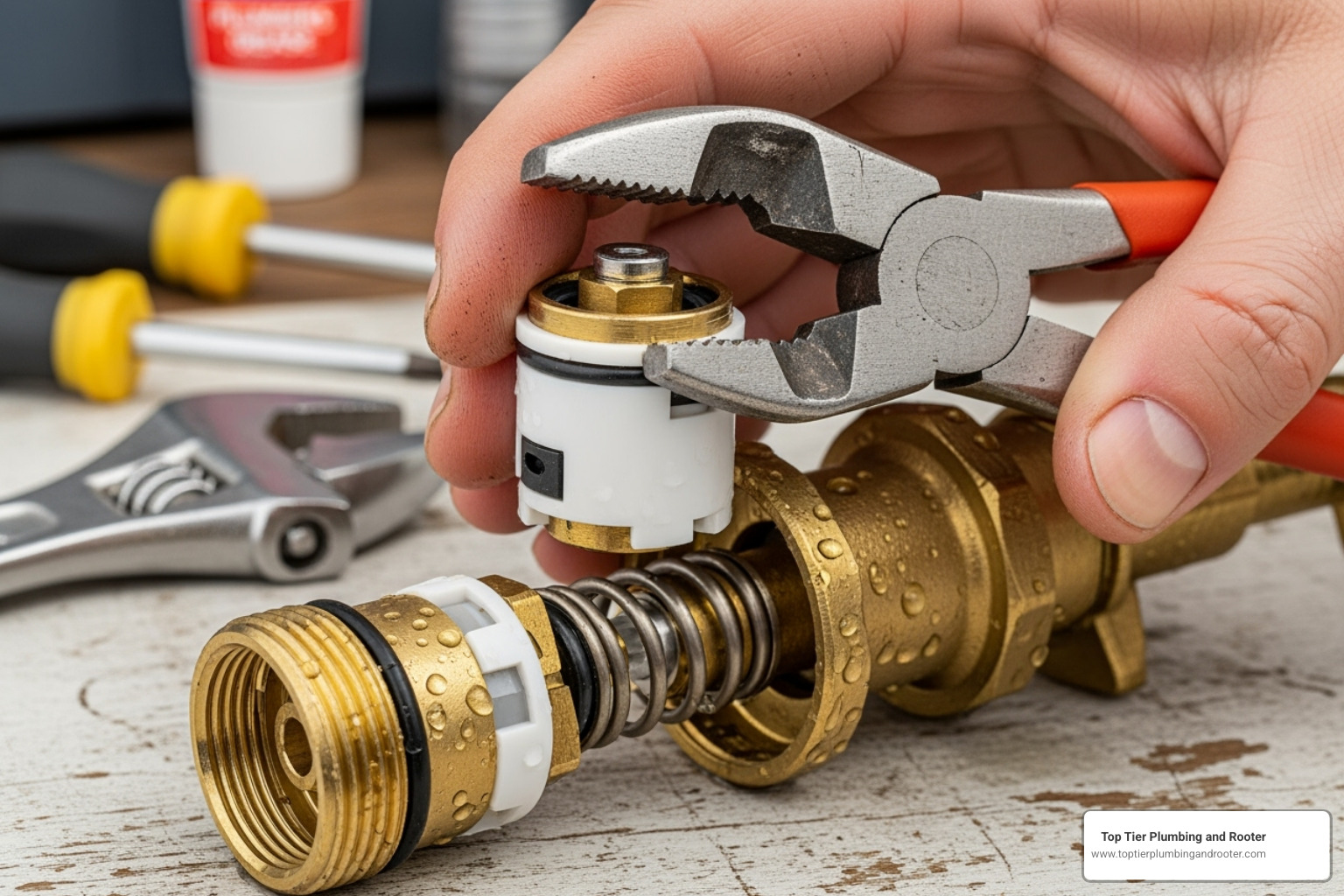
Just like aerators, cartridges can get clogged with mineral deposits and sediment buildup. Our local hard water is particularly good at creating these blockages, turning what should be smooth water flow into a disappointing dribble.
Before you start this repair, turn off both shutoff valves under your sink and run the faucet to drain any remaining water. Safety first!
Removing the cartridge requires a bit more detective work since every faucet model is different. You’ll typically need to remove a decorative cap on the handle to expose a screw, then take off the handle itself. Once you can see the cartridge, it might be held by a retaining nut, clip, or another screw.
Pull the cartridge straight up and out – you might need pliers for a snug fit, but be gentle. Once it’s out, inspect it for buildup and debris. The same vinegar treatment that worked on your aerator can work wonders here too. Soak it for several hours, then scrub with your trusty toothbrush.
If the cartridge looks damaged or excessively corroded, or if cleaning doesn’t restore your pressure, it’s time for a replacement. Take the old cartridge to your local plumbing supply store to ensure you get an exact match for your faucet model.
Reassemble everything in reverse order, turn your shutoff valves back on, and test your pressure. This fix tackles many stubborn low water pressure sink problems that simpler solutions can’t touch.
If this process feels overwhelming or you’re not comfortable diving into your faucet’s guts, don’t worry – that’s exactly what we’re here for. Our team handles all kinds of Comprehensive Plumbing Repairs: Keeping Your Home in Top Shape, and we’re always happy to take the guesswork out of plumbing repairs.
When the Problem is Deeper: Leaks, Pipes, and Water Heaters
Sometimes the culprit behind your low water pressure sink isn’t something you can simply unscrew and clean. The problem might be lurking deeper within your plumbing system – hidden leaks stealing your water pressure, corroded pipes that have narrowed over decades, or a water heater that’s seen better days.
These deeper issues can be sneaky. While you’re focused on that frustrating trickle from your kitchen faucet, water might be escaping somewhere behind your walls or your pipes might be slowly choking themselves with mineral buildup. The tricky part? These problems often start small but can snowball into major headaches if left unchecked.
Corroded pipes are particularly common in older homes, especially those with galvanized steel plumbing. Over the years, these pipes develop rust and mineral deposits on their inner walls, essentially shrinking the pathway for water to flow through. It’s like trying to drink a thick milkshake through a coffee stirrer – everything slows to a crawl.
Water heater sediment is another sneaky troublemaker. All that mineral-rich water flowing through your system leaves behind tiny deposits that settle at the bottom of your water heater tank. Eventually, this buildup can block outlets and reduce your hot water pressure significantly.
For a comprehensive look at diagnosing these trickier pressure problems throughout your home, check out our detailed guide on How to Identify and Fix Low Water Pressure Issues in Your Home.
Signs of a Hidden Plumbing Leak
Here’s something that might surprise you: even a small leak can dramatically impact your water pressure. When water escapes from your pipes before reaching your faucet, there’s simply less pressure available to push through your low water pressure sink.
The challenge with leaks is they’re master hide-and-seek players. They love to hang out behind walls, under floors, or in dark cabinet corners where you rarely look. But your home usually drops hints when there’s trouble brewing.
Puddles under your sink are the most obvious red flag. Make it a habit to peek under your kitchen sink every few weeks – a small drip today can become a flood tomorrow. Musty odors are another telltale sign, especially that persistent mildewy smell that just won’t go away no matter how much you clean.
Keep an eye out for warped floorboards or peeling paint around your sink area. Water damage loves to show off through discolored spots, bubbling wallpaper, or materials that suddenly don’t lie flat anymore. Sometimes the damage appears on nearby walls or even the ceiling below if you’re dealing with an upper-level sink.
Your water bill can be your best detective tool. If it suddenly jumps without any change in your daily routine, water is probably escaping somewhere it shouldn’t be. You can even play detective with your water meter – turn off every faucet and appliance in your house, note the meter reading, then check it again a few hours later. If those numbers moved, you’ve got a leak.
The EPA provides a helpful checklist to find leaks that can guide you through a systematic search. For more hands-on leak troubleshooting, our article on Easy Steps to Fight a Leaky Sink offers practical solutions you can try.
Hot Water Pressure Problems
If your low water pressure sink only acts up when you turn the hot water handle, your water heater is probably crying out for attention. This is actually great news for troubleshooting – when the problem is isolated to hot water only, it narrows down our suspect list considerably.
Sediment buildup is the biggest troublemaker in water heaters. Think of it like this: every gallon of water that flows through your heater leaves behind tiny mineral deposits. Over months and years, these deposits pile up at the bottom of your tank like snow accumulating during a storm. Eventually, this sediment mountain can block the hot water outlet or take up so much space that your heater can’t function properly.
Flushing your water heater annually can prevent this buildup from becoming a major problem. It’s like giving your water heater a good internal cleaning by draining out all that accumulated gunk. While some handy homeowners tackle this themselves, it’s often worth having a professional handle it to avoid any mishaps.
A broken dip tube is another sneaky culprit. This plastic tube carries cold water down to the bottom of your tank to be heated. When it breaks or comes loose, cold water mixes with your hot water at the top of the tank, giving you lukewarm water and reduced pressure. You might even find small plastic pieces in your aerator if this is happening.
Don’t forget about the faulty shutoff valve on your water heater’s hot water line. Just like the valves under your sink, this one can get stuck partially closed or develop internal problems that restrict flow.
If flushing your water heater doesn’t solve your hot water pressure problems, it’s time to call in the professionals. Water heaters have internal components that require specialized knowledge to diagnose and repair safely.
Frequently Asked Questions about Low Sink Water Pressure
We get a lot of questions about low water pressure sink issues from homeowners throughout Riverside and San Bernardino counties. After years of helping folks troubleshoot their plumbing problems, we’ve noticed the same concerns come up again and again. Here are the answers to the most common questions we hear:
Why is only my kitchen sink’s water pressure low?
When just one sink is acting up while the rest of your faucets work perfectly, you’re actually in luck! This means the problem is localized to that specific fixture, which makes it much easier (and usually cheaper) to fix.
The culprit is most likely a clogged aerator – that little screen at the tip of your faucet that gets gunked up with mineral deposits and debris. We see this constantly in our area because of our hard water. Sometimes it’s a blocked faucet cartridge inside the faucet mechanism, or occasionally an issue with the shutoff valves or supply lines tucked away under that particular sink.
The good news? These are often the easiest problems to tackle yourself! We always tell homeowners to start with the simplest solutions first, like unscrewing and cleaning that aerator, before moving on to more complex detective work.
Can hard water cause low water pressure?
Absolutely, and this is a big issue here in Riverside and San Bernardino counties. Our local water supply is loaded with minerals like calcium and magnesium, and while these aren’t harmful to drink, they’re not so friendly to your plumbing.
Over time, these minerals build up inside your pipes, aerators, and faucet cartridges like barnacles on a ship’s hull. This buildup literally narrows the passage for water, creating bottlenecks that restrict flow and cause that frustrating low pressure. Think of it like trying to drink a milkshake through a straw that’s getting more clogged by the minute.
Regular cleaning of aerators and annual flushing of your water heater can help fight back against hard water’s effects. It’s an ongoing battle, but one that’s definitely worth fighting to keep your water flowing freely.
What are the consequences of ignoring low water pressure?
Here’s where we get serious for a moment. While low water pressure might seem like just an annoying inconvenience, ignoring it can lead to much bigger headaches down the road.
If the pressure drop is caused by a hidden leak, you’re looking at potential water damage, mold growth, and structural problems that can cost thousands to repair. When it’s due to pipe corrosion, those pipes could eventually fail completely, leading to burst pipes and major flooding – definitely not something you want to find when you’re away on vacation!
Beyond the scary stuff, low pressure also makes your appliances work harder and less efficiently. Your dishwasher won’t clean dishes properly, your washing machine will take forever to fill, and simple tasks like washing your hands become exercises in patience.
Most importantly, low water pressure is often your plumbing system’s way of waving a red flag, telling you there’s a larger underlying problem brewing. Catching these issues early can save you from much more expensive repairs later. So while that weak trickle is definitely frustrating, think of it as your home’s way of asking for help before things get really messy!
When to Call a Professional Plumber
While many low water pressure sink issues can be resolved with a bit of DIY effort, there comes a point when it’s time to wave the white flag and call in the cavalry. We totally understand the satisfaction of fixing things yourself – there’s nothing quite like the victory dance after successfully unclogging an aerator! But knowing when to seek expert help can actually save you time, money, and a lot of frustration.
If your DIY attempts have failed and you’ve already tried cleaning the aerator, checking those sneaky shutoff valves, and even wrestling with the faucet cartridge, yet your low water pressure sink persists, it’s telling you the problem runs deeper than surface-level fixes can handle.
Persistent low pressure that affects multiple faucets throughout your home is a red flag waving frantically. This usually points to larger issues within your main water supply line, a faulty pressure regulator, or even problems with the municipal water supply that require specialized diagnostic equipment to identify properly.
Any suspected leak should have you reaching for the phone immediately. Those musty smells, mysterious water stains, suddenly high water bills, or the sound of running water when everything should be quiet are all your home’s way of crying for help. Leaks are like that small snowball rolling down a hill – they start small but can quickly become an avalanche of damage to your home’s structure and lead to mold growth.
If your home has older corroded pipes, particularly those galvanized steel ones we mentioned earlier, you’re looking at a major undertaking that requires professional expertise. Pipe replacement isn’t exactly a weekend DIY project, and attempting it without proper knowledge can turn a fixable problem into a plumbing disaster.
Water heater service becomes necessary when your low hot water pressure persists even after flushing the tank. Internal components like broken dip tubes or faulty heating elements require trained technicians who can safely diagnose and repair these issues without risking damage to your water heater or your home.
Sometimes, the most honest answer is simply lack of confidence or the right tools. If you’re feeling uncomfortable about any of these repair steps, or if you don’t have the necessary equipment, there’s absolutely no shame in calling for backup. Attempting repairs without proper knowledge can often lead to bigger problems – and bigger repair bills.
At Top Tier Plumbing and Rooter, we’ve seen it all when it comes to low water pressure sink problems throughout Riverside and San Bernardino counties. We’re available 24/7 with same-day service, and we believe in upfront pricing with 100% satisfaction guaranteed. Whether it’s a tricky cartridge replacement or a complex whole-house pressure issue, we’re here to get your water flowing properly again.
Professional plumbing services ensure the job gets done correctly and safely the first time, giving you that peace of mind that’s worth its weight in gold. You can learn more about The Benefits of Professional Plumbing Services: Why Expertise Matters to understand the real value expert help brings to your home.
Don’t let that frustrating trickle continue to turn simple kitchen tasks into lengthy ordeals. For expert faucet and sink repairs, contact us today! We’re ready to restore your water pressure and bring the joy back to your kitchen – no more waiting five minutes to fill a coffee pot!


